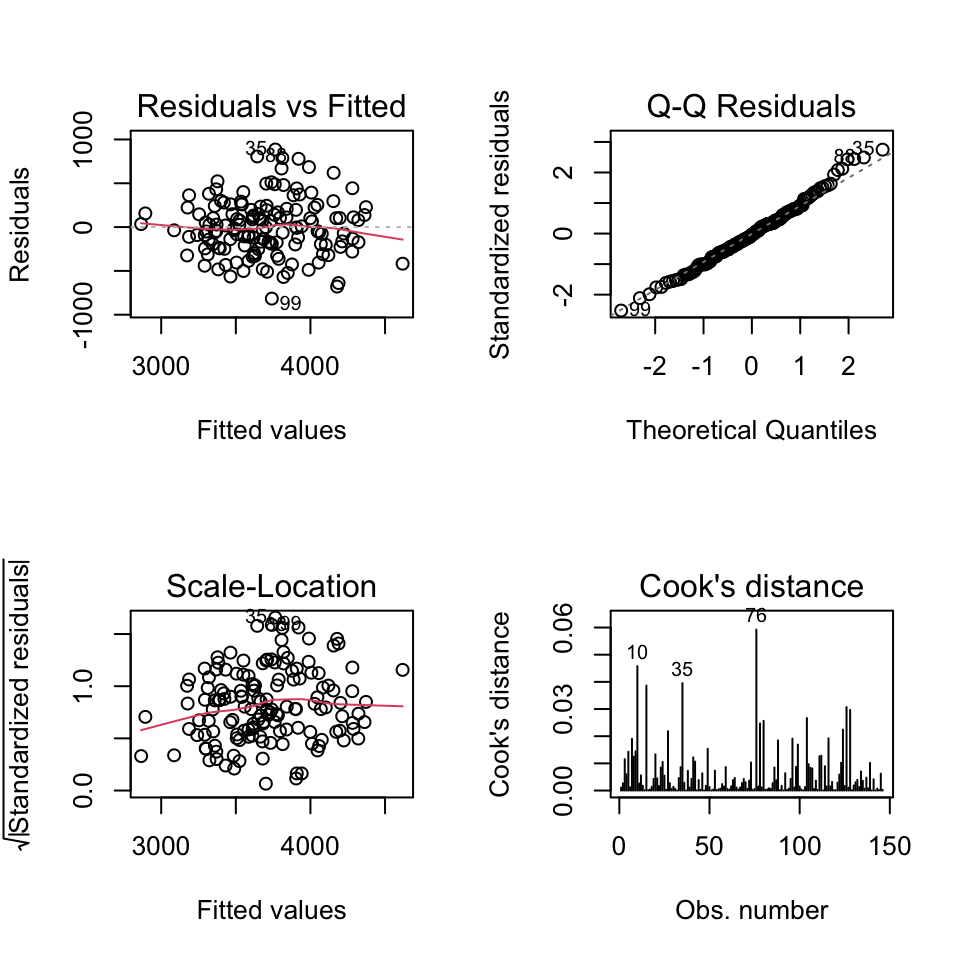01:00

Multiple lineare Regression und Modellselektion
DS3 - Vom experimentellen Design zur
explorativen Datenanalyse & Data Mining
Saskia Otto & Monika Eberhard
Universität Hamburg, IMF
Wintersemester 2025/2026
Lernziele
![]()
Am Ende dieser VL- und Übungseinheit werden Sie
- die Unterschiede zwischen einer einfachen und einer multiplen Regression kennen.
- wissen, warum und wie auf (Multi-)Kollinearität vorab geprüft werden muss.
- weitere Kriterien für die Modellauswahl kennen und im Rahmen einer ‘backward selection’ anwenden können.
- wissen, was mit Ockhams Rasiermesser gemeint ist.
Regression mit
≥ 2 Kovariaten

Multiple Regression | Ziel
- Identifizierung des Einflusses mehrerer unabhängiger Kovariaten X_p auf die Antwortvariable unter Berücksichtigung der Beziehungen zwischen den Kovariaten.
- Vorhersage von Y-Werten aus den Werten mehrerer X-Variablen.
- Bestimmung der einflussreichsten Parameter aus mehreren unabhängigen Variablen → empirische Variablenauswahl.
Multiple Regression | Gleichung
Die Grundsätze einer einfachen, bivariaten Regressionsanalyse lassen sich auf zwei oder mehr kontinuierliche Variablen ausweiten:

Faustregel: nicht mehr als 10 erklärende Variablen
Multiple Regression | Neu
- Zusätzliche Annahmen / Datenexplorationen
- Schätzung der Parameter (Achsenabschnitt \alpha & partielle Regressionskoeffizienten \beta_p)
- Signifikanztest
- (Multiples) R^2 vs. korrigiertes R^2
- Modellauswahl
Zusätzliche Annahmen
- Wie bei der einfachen (bivariaten) Regression
- Normalität
- Homogenität
- Unabhängigkeit
- Linearität
- NEU
- Anzahl der Kovariaten < Anzahl der Beobachtungen (p < n)
- Keine lineare Beziehung zwischen den Kovariaten (keine Kollinearität / Multikollinearität)
Problem der Kollinearität
- Kleine Änderungen in den Daten → extreme Änderungen in den Regressionskoeffizienten
- Schätzungen zwischen verschiedenen Stichproben derselben Population können stark voneinander abweichen → hohe Standardfehler der geschätzten Parameter
- Schätzungen von \beta’s und Signifikanztests unzuverlässig.
Problem der Kollinearität | Demo
![]()
Link zur Shiny-App: teaching-stats/collinearity/
Prüfen auf Kollinearität
- Paarweise Korrelation und Streudiagramme
- Berechnung des VIF-Werts für jede Kovariate → in R z.B. mit
car::vif()
VIF-Wert
VIF_i = \frac{1}{TOL_i} = \frac{1}{1-R_i^2}
- R^2 hier aus Modell, welches alle Kovariaten enthält, außer der Kovariate, für die der VIF-Wert berechnet wird.
- Faustregel: VIF > 3 ist problematisch (einige sagen VIF>10, hängt auch von der Anzahl an Kovariaten ab)
- Wenn Kovariaten einen VIF > 3 haben,
- → die Kovariate mit dem höchsten VIF entfernen (oder nach biologischem Wissen/Interesse entscheiden)
- → die VIFs für die verbleibenden Kovariaten neu berechnen
- → fortfahren, bis alle Kovariaten VIFs < 3 haben.
Weitere Datenexploration
- Unabhängigkeit (posteriori)
- Visualisieren Sie im Streudiagramm die Residuen gegen die einzelnen erklärenden Variablen (auch diejenigen, die aus dem endgültigen Modell ausgeschlossen wurden) und suchen Sie nach einem Muster.
- Interaktionen (a priori)
- Darstellung von Y gegen X_1, X_2,… in Abhängigkeit von einer anderen Kovariate
- Nützliche Funktion
coplot()
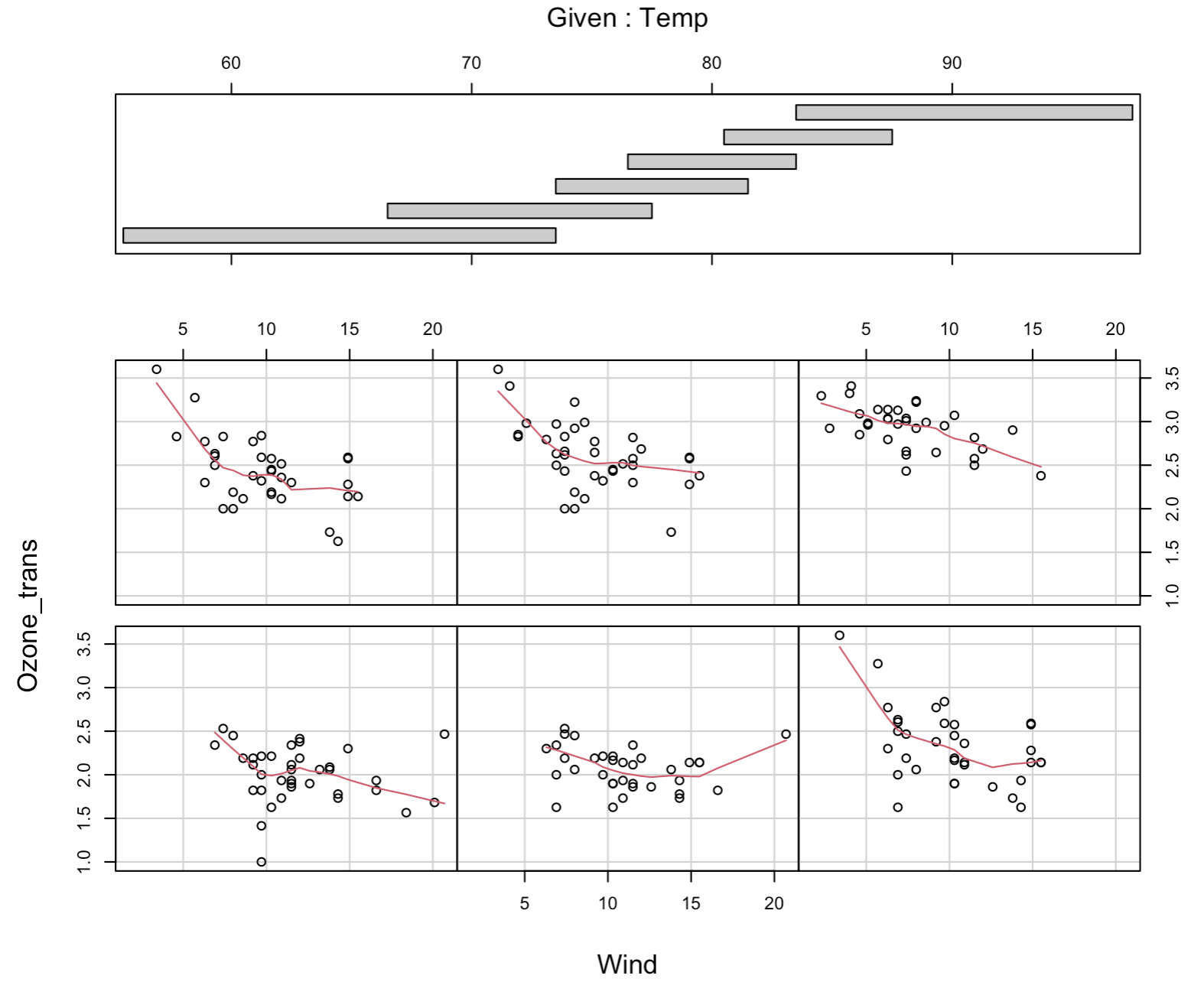
Parameterschätzung
- Achsenabschnitt (intercept) \alpha
- Wert von Y, wenn alle X-Werte gleich Null sind → weniger wichtig
- Partielle Regressionskoeffizienten (slopes) \beta_p (\beta_1, \beta_2,.. )
- Effekt einer Erhöhung von X_p um 1 Einheit, wobei alle anderen Kovariaten oder Prädiktoren (X) konstant bleiben
- Regressionskoeffizienten der Stichprobe (a, b_p) werden mit OLS Methode geschätzt.
- \hat{y}_i = a + b_1 x_{1,i} + b_2 x_{2,i} + ...
\hat{y}_i = \text{vorhergesagter Y-Wert für jede Kombination von X-Werten}
Signifikanztests | Partielle Koeffizienten
- H_0:\beta_p = 0
- Getrennte t-Tests für jeden partiellen Regressionskoeffizienten im Modell
- Partielle t-Tests verwenden: t_p = \frac{b_p}{s.e.(b_p)}
- Vergleich mit t-Verteilung mit N-2 Freiheitsgraden
- H_0 verwerfen, wenn p < 0.05
Anpassung des Bestimmtheitsmaß


Lösung: korrigiertes Bestimmtheitsmaß

Modellauswahl

Ausgangssituation
- Wir wollen das optimale Modell finden, das die Parameter identifiziert, die die gesammelten Daten am besten erklären.
- Aber welches von allen möglichen Modellen passt am besten zu den Daten?
- Viele mögliche Modelle
- für p Prädiktoren, # mögliche Modelle = 2^p
- → 6 Prädiktoren, 64 mögliche Modelle
- → 10 Prädiktoren, 1024 mögliche Modelle
- Effiziente Suchverfahren erforderlich
- Verschiedene Ansätze und unterschiedliche Kriterien für die Auswahl des “besten” Modells
- Sparsamkeitsprinzip (principle of parsimony)
Sparsamkeitsprinzip
Oder Ockhams Rasiermesser
Das Prinzip der Parsimonie wird dem englischen Philosophen William von Ockham aus dem frühen 14. Jahrhundert zugeschrieben, der darauf bestand, dass bei einer Reihe gleichwertiger Erklärungen für ein bestimmtes Phänomen die einfachste Erklärung die richtige ist. Sie wird Ockhams Rasiermesser genannt, weil er seine Erklärungen auf das absolute Minimum ‘rasierte’.
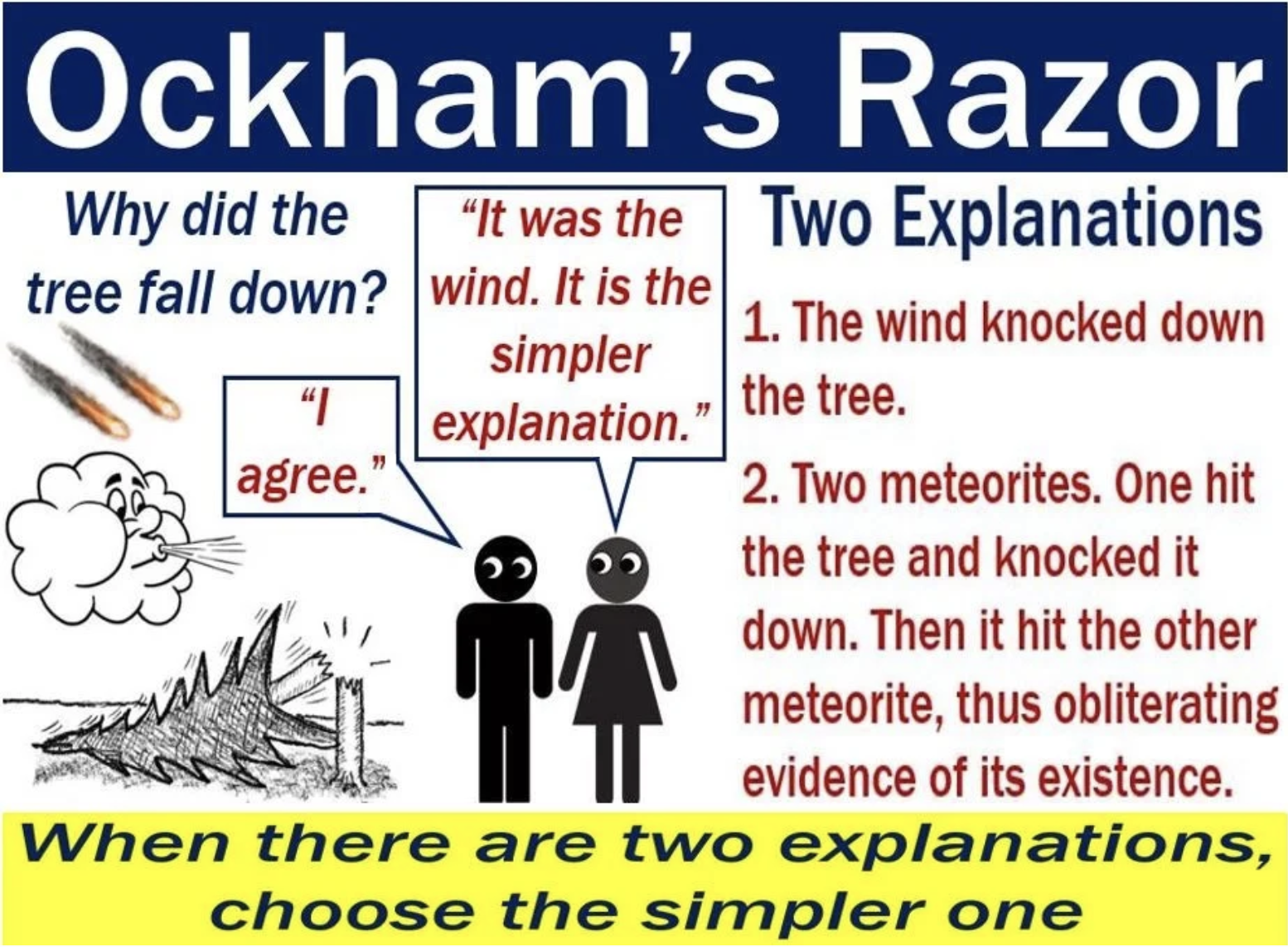
Video – What is Ockham’s Razor?
Kriterien der Modellauswahl
- Hypothesentests (z.B. der F-Test)
- Korrigiertes R^2 → je höher desto besser → absolutes Maß
- Akaike’s Informationskriterium (AIC) → je niedriger desto besser → relatives Maß
- Faustregel: Wenn der Unterschied zwischen 2 Modellen im AIC ≤ 2 beträgt, sollte das einfachere Modell gewählt werden.
- Berücksichtigt das Maß der Anpassungsgüte und fügt einen so genannten Strafterm für die Anzahl der unabhängigen Parameter im Modell hinzu.

- Bayesian Informationskriterium (BIC)
- Gibt der Anzahl an Kovariaten mehr Gewicht
- Empfehlenswert, wenn p > 7
‘All subsets selection’
- Vergleich ausgewählter Teilmengen von Modellen und Wahl des optimalen Modells mittels AIC oder BIC.
- Kann zu einer großen Anzahl von zu vergleichenden Modellen führen.
- Viele Iterationen und zeitaufwändig, wenn p > 5.
- Die Anzahl kann jedoch reduziert werden, indem a priori einige Teilmengen auf der Grundlage ökologischer Kenntnisse ausgewählt werden.
‘Stepwise selection’
- Untersuchung einer Teilmenge möglicher Modelle auf der Grundlage eines bestimmten Kriteriums.
- Sog. ‘forward selection’
- Sog. ‘backward selection’:
- Startet mit allen Prädiktoren (volles Modell) und entfernt eine Variable bzw. einen Term nach dem anderen bis R_{adj}^2 sinkt bzw. der AIC steigt.
- ’stepwise selection’:
- kombiniert vorwärts und rückwärts gerichtete Auswahl
‘Backward selection’ | 1
Wir starten mit allen Variablen und Interaktionen

→ Höchstwahrscheinlich viel zu viele Variablen und Interaktionen im Modell.
‘Backward selection’ | 2
Schrittweises Entfernen





Modell sollte möglichst simpel sein → erst die komplexeren, dann die weniger komplexen Terme entfernen.
‘Backward selection’ | 3
Schrittweises Entfernen
- Also erst Entfernen komplexer Interaktionsterme (z.B. 4er- vor 3er-Interaktion).
- Einzelne Variablen werden (meistens) erst ganz zum Schluss entfernt.
- Solange eine Variable in einer Interaktion auftritt, darf die Variable selbst nicht entfernt werden.
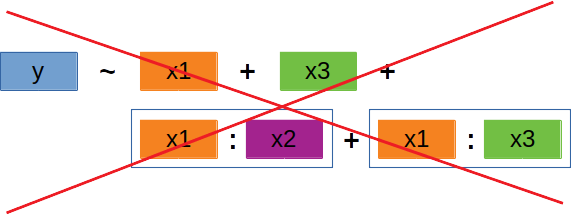

‘Backward selection’ | 4
Schrittweises Entfernen
- Es ist durchaus möglich, einzelne Variablen zu entfernen, bevor eine Interaktion entfernt wird → solange diese Variablen nicht Teil der Interaktion sind!


Your turn …
![]()
Quiz 1 | Formelschreibweise
![]()
![]()
Folgender Datensatz ist gegeben:
'data.frame': 20 obs. of 5 variables:
$ Y : num 508 511 535 534 500 ...
$ X1: num 4.4 7.7 25.6 10.7 11.3 ...
$ X2: num 989 998 990 993 994 ...
$ X3: num 0.244 0.668 0.418 0.788 0.103 ...
$ X4: num 3.13 2.99 2.98 3.68 2.89 ...Erstellen Sie nun die Formel für ein multiples Regressionsmodell, dass die Effekte
- der vier Variablen X1, X2, X3, X4,
- der 2-Wege Interaktion zwischen X2 und X4,
- sowie der 3-Wege-Interaktion zwischen X1, X3, und X4 testet.
- Höhere Interaktionen messen, wie sich Interaktionseffekte selbst verändern, wenn eine weitere Variable dazu kommt.
- Beispiel: der 3-Wege-Term X1:X3:X4 sagt aus, ob die Effekte der 2-Wege-Interaktionen wie X1:X3, X1:X4 und X3:X4 jeweils von der dritten X Variable abhängen.
- Damit das interpretierbar ist, braucht man alle drei 2-Wege-Interaktionsterme schon im Modell.
- Bei der Modellauswahl dürfen immer nur die höheren Interaktionsterme entfernt werden.
- Die zugehörigen niedrigeren Terme (Haupteffekte und 2-Wege-Interaktionen) müssen im Modell bleiben, solange ein höherer Interaktionsterm sie enthält.
- In unserem Beispiel könnten also nur die 3-Wege-Terme X1:X3:X4 oder X2:X4 entfernt werden – nicht aber die 2-Wege-Interaktionen, die darin verschachtelt sind.
- Genau das berücksichtigt die
step()-Funktion automatisch (siehe erster Step; mehr zur Funktion im Praxisbeispiel in R):
Start: AIC=98.15
Y ~ X1 + X2 + X3 + X4 + X2:X4 + X1:X3 + X1:X4 + X3:X4 + X1:X3:X4
Df Sum of Sq RSS AIC
- X1:X3:X4 1 3.3703 998.99 96.220
- X2:X4 1 9.6507 1005.27 96.346
<none> 995.62 98.153
Step: AIC=96.22
Y ~ X1 + X2 + X3 + X4 + X2:X4 + X1:X3 + X1:X4 + X3:X4
Df Sum of Sq RSS AIC
- X3:X4 1 0.377 999.37 94.228
- X2:X4 1 6.806 1005.80 94.356
- X1:X4 1 9.490 1008.48 94.409
<none> 998.99 96.220
- X1:X3 1 114.064 1113.06 96.383
Step: AIC=94.23
Y ~ X1 + X2 + X3 + X4 + X2:X4 + X1:X3 + X1:X4
Df Sum of Sq RSS AIC
- X2:X4 1 9.225 1008.59 92.412
- X1:X4 1 12.484 1011.85 92.476
<none> 999.37 94.228
- X1:X3 1 124.140 1123.51 94.570
Step: AIC=92.41
Y ~ X1 + X2 + X3 + X4 + X1:X3 + X1:X4
Df Sum of Sq RSS AIC
- X2 1 2.636 1011.2 90.464
- X1:X4 1 5.278 1013.9 90.516
<none> 1008.6 92.412
- X1:X3 1 164.745 1173.3 93.438
Step: AIC=90.46
Y ~ X1 + X3 + X4 + X1:X3 + X1:X4
Df Sum of Sq RSS AIC
- X1:X4 1 7.957 1019.2 88.621
<none> 1011.2 90.464
- X1:X3 1 162.391 1173.6 91.442
Step: AIC=88.62
Y ~ X1 + X3 + X4 + X1:X3
Df Sum of Sq RSS AIC
- X4 1 72.257 1091.4 87.990
<none> 1019.2 88.621
- X1:X3 1 154.581 1173.8 89.445
Step: AIC=87.99
Y ~ X1 + X3 + X1:X3
Df Sum of Sq RSS AIC
<none> 1091.4 87.990
- X1:X3 1 118.13 1209.6 88.046
Call:
lm(formula = Y ~ X1 + X3 + X1:X3, data = df)
Coefficients:
(Intercept) X1 X3 X1:X3
500.81466 0.09578 38.28042 1.00001 Praxisbeispiel in R

Beispiel in R
‘airquality’-Datensatz
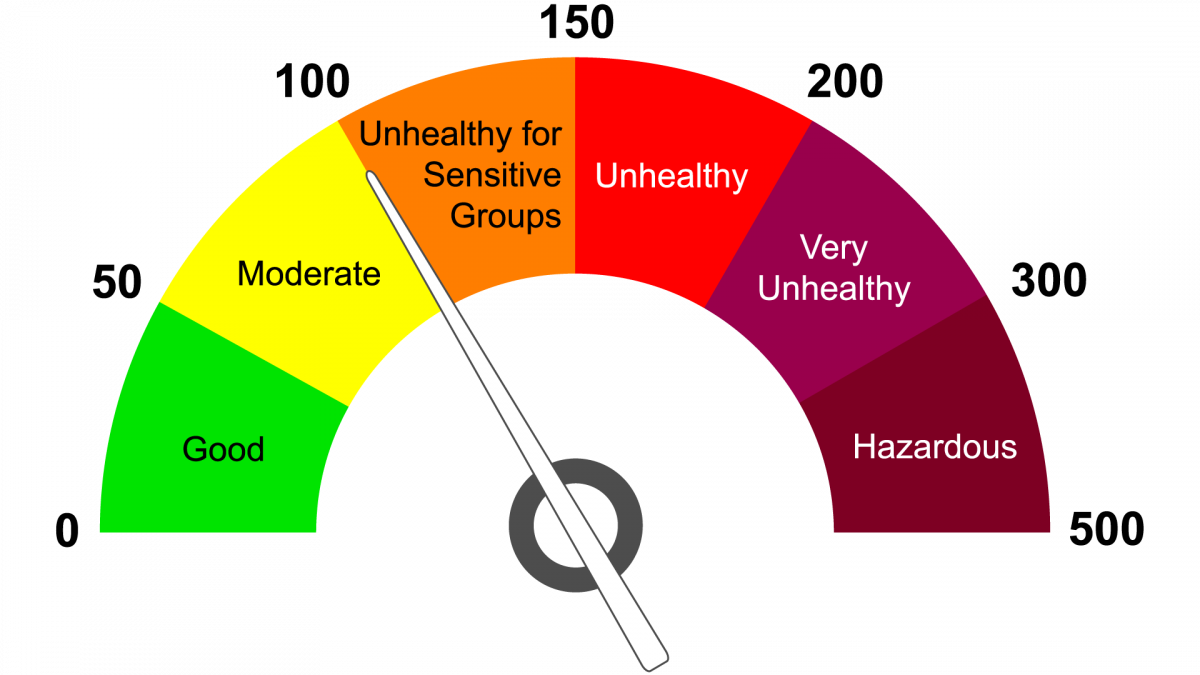
Enthält Luftqualitätsmessungen in New York zwischen Mai und September 1973:
'data.frame': 153 obs. of 6 variables:
$ Ozone : int 41 36 12 18 NA 28 23 19 8 NA ...
$ Solar.R: int 190 118 149 313 NA NA 299 99 19 194 ...
$ Wind : num 7.4 8 12.6 11.5 14.3 14.9 8.6 13.8 20.1 8.6 ...
$ Temp : int 67 72 74 62 56 66 65 59 61 69 ...
$ Month : int 5 5 5 5 5 5 5 5 5 5 ...
$ Day : int 1 2 3 4 5 6 7 8 9 10 ...Fragestellung: Welchen Effekt haben die Sonneneinstrahlung (Solar.R) und die Wind- (Wind) und Temperaturbedingungen (Temp) auf die Ozonwerte (Ozone) bzw. können wir die Ozonwerte anhand dieser 3 Parameter vorhersagen?
Beispiel aus: The R Book von M.J. Crawley → Kapitel 10.13 Multiple Regression
Datenexploration | Verteilung und NAs

- Die Ozonwerte sind stark rechtsschief und eine erste Modellselektion zeigte, dass
Ozontransformiert werden muss (4te-Wurzel). - Alle Zeilen mit NAs (81 insgesamt) werden entfernt.
Datenexploration | Beziehungen

Datenexploration | Kolliniarität

Die vif() Funktion aus dem 'car' Paket
Solar.R Wind Temp
1.095253 1.329070 1.431367 - Keine Kovariate zeigt einen VIF-Wert > 3.
- Es können daher alle im Modell bleiben.
Datenexploration | Interaktionen
![]()
Volles Modell | Validierung

Volles Modell | Numerischer Output

Call:
lm(formula = Ozone_trans ~ Solar.R * Wind * Temp, data = airquality)
Residuals:
Min 1Q Median 3Q Max
-0.64623 -0.19417 -0.04487 0.16945 0.73236
Coefficients:
Estimate Std. Error t value Pr(>|t|)
(Intercept) -1.664e+00 1.549e+00 -1.074 0.2852
Solar.R 6.045e-03 8.431e-03 0.717 0.4750
Wind 1.983e-01 1.275e-01 1.555 0.1231
Temp 5.322e-02 2.118e-02 2.513 0.0135 *
Solar.R:Wind -7.011e-04 7.438e-04 -0.943 0.3481
Solar.R:Temp -5.464e-05 1.118e-04 -0.489 0.6260
Wind:Temp -3.078e-03 1.801e-03 -1.709 0.0905 .
Solar.R:Wind:Temp 8.789e-06 1.005e-05 0.874 0.3839
---
Signif. codes: 0 '***' 0.001 '**' 0.01 '*' 0.05 '.' 0.1 ' ' 1
Residual standard error: 0.2755 on 103 degrees of freedom
Multiple R-squared: 0.7139, Adjusted R-squared: 0.6945
F-statistic: 36.72 on 7 and 103 DF, p-value: < 2.2e-16Modellauswahl | ‘backward selection’ 1
Auswahlkriterium: AIC → AIC()

Schritt 2: Enfernen der drei 2-Wege-Interaktionen
df AIC
mod_step1 8 37.31636
mod_step2a 7 35.67992
mod_step2b 7 36.56975
mod_step2c 7 39.48241Modellauswahl | ‘backward selection’ 2
Auswahlkriterium: AIC → AIC()

Schritt 3: Enfernen der restlichen 2-Wege-Interaktionen
df AIC
mod_step2a 7 35.67992
mod_step3a 6 35.38642
mod_step3b 6 39.73598Schritt 4: Enfernen der letzten 2-Wege-Interaktion und Solar.R
df AIC
mod_step3a 6 35.38642
mod_step4a 5 52.50390
mod_step4b 5 42.30848→ Bestes Modell: mit allen 3 Kovariaten und der Wind:Temp Interaktion
Modellauswahl | Automatische Auswahl
Automatische ‘backward selection’ mit step()

Start: AIC=-278.51
Ozone_trans ~ Solar.R * Wind * Temp
Df Sum of Sq RSS AIC
- Solar.R:Wind:Temp 1 0.058039 7.875 -279.69
<none> 7.817 -278.51
Step: AIC=-279.69
Ozone_trans ~ Solar.R + Wind + Temp + Solar.R:Wind + Solar.R:Temp +
Wind:Temp
Df Sum of Sq RSS AIC
- Solar.R:Wind 1 0.025836 7.9008 -281.32
- Solar.R:Temp 1 0.089427 7.9644 -280.44
<none> 7.8750 -279.69
- Wind:Temp 1 0.301181 8.1762 -277.52
Step: AIC=-281.32
Ozone_trans ~ Solar.R + Wind + Temp + Solar.R:Temp + Wind:Temp
Df Sum of Sq RSS AIC
- Solar.R:Temp 1 0.12240 8.0232 -281.62
<none> 7.9008 -281.32
- Wind:Temp 1 0.44304 8.3439 -277.27
Step: AIC=-281.62
Ozone_trans ~ Solar.R + Wind + Temp + Wind:Temp
Df Sum of Sq RSS AIC
<none> 8.0232 -281.62
- Wind:Temp 1 0.67153 8.6948 -274.70
- Solar.R 1 1.50797 9.5312 -264.50
Call:
lm(formula = Ozone_trans ~ Solar.R + Wind + Temp + Wind:Temp,
data = airquality)
Coefficients:
(Intercept) Solar.R Wind Temp Wind:Temp
-1.364170 0.001347 0.129726 0.050008 -0.002197 ‘Optimales’ Modell | Validierung 1

‘Optimales’ Modell | Validierung 2

Zusätzliche Plots manuell erstellt:
Code
res <- residuals(mod_final)
fit <- fitted(mod_final)
par(mfrow = c(2,3))
hist(res)
plot(airquality$Ozone_trans ~ fit, main = "Vorhersage-Performance"); abline(0,1)
# Unabhaengigkeitscheck: Residuen vs. jede erklaerende Var.
plot(0, 0, type = "n", axes = FALSE, xlab="", ylab="")
plot(res ~ airquality$Solar.R); abline(0,0)
plot(res ~ airquality$Wind); abline(0,0)
plot(res ~ airquality$Temp); abline(0,0)
‘Optimales’ Modell | Numerischer Output

Call:
lm(formula = Ozone_trans ~ Solar.R + Wind + Temp + Wind:Temp,
data = airquality)
Residuals:
Min 1Q Median 3Q Max
-0.6036 -0.2040 -0.0415 0.1940 0.7572
Coefficients:
Estimate Std. Error t value Pr(>|t|)
(Intercept) -1.3641697 0.6571265 -2.076 0.04032 *
Solar.R 0.0013472 0.0003018 4.463 2.02e-05 ***
Wind 0.1297264 0.0579676 2.238 0.02732 *
Temp 0.0500078 0.0080260 6.231 9.56e-09 ***
Wind:Temp -0.0021973 0.0007377 -2.979 0.00359 **
---
Signif. codes: 0 '***' 0.001 '**' 0.01 '*' 0.05 '.' 0.1 ' ' 1
Residual standard error: 0.2751 on 106 degrees of freedom
Multiple R-squared: 0.7064, Adjusted R-squared: 0.6953
F-statistic: 63.75 on 4 and 106 DF, p-value: < 2.2e-16Modellvisualisierung (mit plotly)

Solar.R Effekt
Kombinierter Effekt von Wind und Temp
Code
library(plotly)
df <- data_grid(airquality,
Wind = seq_range(Wind, 50),
Temp = seq_range(Temp, 50),
.model = mod_final) |>
add_predictions(model = mod_final)
df_wide <- df |>
pivot_wider(names_from = Wind,
values_from = pred) |>
select(-c(1:2)) |>
as.matrix()
p1 <- plot_ly(airquality,
x = ~ Wind,
y = ~ Temp,
z = ~ Ozone_trans,
type = "scatter3d")
add_trace(p = p1,
z = df_wide,
x = seq_range(airquality$Wind, 50),
y = seq_range(airquality$Temp, 50),
type = "surface")Your turn …
![]()
05:00
Multiple Regression mit penguins

Wir greifen nun wieder den Datensatz aus dem ‘palmerpenguins’ Paket auf, den Sie bereits aus der ANCOVA-Übung kennen.
- Dieses Mal beschränken wir uns auf die Art Adelie.
- Wir prüfen mittels multipler Regression, ob Schnabellänge (
bill_length_mm), Schnabeltiefe (bill_depth_mm) und Flossenlänge (flipper_length_mm) das Körpergewicht (body_mass_g) erklären können – und welche dieser Variablen den größten Einfluss hat.
data(penguins, package = "palmerpenguins")
subs <- penguins |> filter(species == 'Adelie') |>
drop_na()
str(subs)tibble [146 × 8] (S3: tbl_df/tbl/data.frame)
$ species : Factor w/ 3 levels "Adelie","Chinstrap",..: 1 1 1 1 1 1 1 1 1 1 ...
$ island : Factor w/ 3 levels "Biscoe","Dream",..: 3 3 3 3 3 3 3 3 3 3 ...
$ bill_length_mm : num [1:146] 39.1 39.5 40.3 36.7 39.3 38.9 39.2 41.1 38.6 34.6 ...
$ bill_depth_mm : num [1:146] 18.7 17.4 18 19.3 20.6 17.8 19.6 17.6 21.2 21.1 ...
$ flipper_length_mm: int [1:146] 181 186 195 193 190 181 195 182 191 198 ...
$ body_mass_g : int [1:146] 3750 3800 3250 3450 3650 3625 4675 3200 3800 4400 ...
$ sex : Factor w/ 2 levels "female","male": 2 1 1 1 2 1 2 1 2 2 ...
$ year : int [1:146] 2007 2007 2007 2007 2007 2007 2007 2007 2007 2007 ...Quiz 2 | Interpretation Datenepxloration
Prüfung auf Kollinearität
Quiz 2 | Interpretation Datenepxloration
Prüfung auf Kollinearität
![]()
Quiz 3 | Modellspezifikation und -auswahl
![]()
Quiz 4 | Diagnosikplots des vollen Modells
![]()
Quiz 5 | Interpretation Modellauswahl
![]()
![]()
Wie ist die automatische Backward-Selection mit der step() zu interpretieren (das Quiz befindet sich am Ende)?
Start: AIC=1700.02
body_mass_g ~ bill_length_mm * bill_depth_mm * flipper_length_mm
Df Sum of Sq RSS AIC
- bill_length_mm:bill_depth_mm:flipper_length_mm 1 37991 14954786 1698.4
<none> 14916795 1700.0
Step: AIC=1698.39
body_mass_g ~ bill_length_mm + bill_depth_mm + flipper_length_mm +
bill_length_mm:bill_depth_mm + bill_length_mm:flipper_length_mm +
bill_depth_mm:flipper_length_mm
Df Sum of Sq RSS AIC
- bill_depth_mm:flipper_length_mm 1 812 14955598 1696.4
- bill_length_mm:flipper_length_mm 1 9282 14964068 1696.5
- bill_length_mm:bill_depth_mm 1 89536 15044322 1697.3
<none> 14954786 1698.4
Step: AIC=1696.4
body_mass_g ~ bill_length_mm + bill_depth_mm + flipper_length_mm +
bill_length_mm:bill_depth_mm + bill_length_mm:flipper_length_mm
Df Sum of Sq RSS AIC
- bill_length_mm:flipper_length_mm 1 8621 14964219 1694.5
- bill_length_mm:bill_depth_mm 1 97474 15053072 1695.3
<none> 14955598 1696.4
Step: AIC=1694.48
body_mass_g ~ bill_length_mm + bill_depth_mm + flipper_length_mm +
bill_length_mm:bill_depth_mm
Df Sum of Sq RSS AIC
- bill_length_mm:bill_depth_mm 1 88933 15053152 1693.3
<none> 14964219 1694.5
- flipper_length_mm 1 1493253 16457472 1706.4
Step: AIC=1693.35
body_mass_g ~ bill_length_mm + bill_depth_mm + flipper_length_mm
Df Sum of Sq RSS AIC
<none> 15053152 1693.3
- flipper_length_mm 1 1500553 16553705 1705.2
- bill_length_mm 1 2447561 17500713 1713.3
- bill_depth_mm 1 3645109 18698261 1723.0
Call:
lm(formula = body_mass_g ~ bill_length_mm + bill_depth_mm + flipper_length_mm,
data = subs)
Coefficients:
(Intercept) bill_length_mm bill_depth_mm flipper_length_mm
-4270.66 54.51 144.16 16.91 # Schritt 1: Enfernen der 3-Wege Interaktion mit update()
mod_full <- lm(body_mass_g ~ bill_length_mm * bill_depth_mm * flipper_length_mm, subs)
mod_step1 <- update(mod_full, .~. - bill_length_mm:bill_depth_mm:flipper_length_mm)
AIC(mod_full, mod_step1) # mod_step1 am besten (niedrigster AIC) df AIC
mod_full 9 2116.351
mod_step1 8 2114.723# Schritt 2: Enfernen der drei 2-Wege-Interaktionen
mod_step2a <- update(mod_step1, .~. - bill_length_mm:bill_depth_mm)
mod_step2b <- update(mod_step1, .~. - bill_length_mm:flipper_length_mm)
mod_step2c <- update(mod_step1, .~. - bill_depth_mm:flipper_length_mm)
AIC(mod_step1, mod_step2a, mod_step2b, mod_step2c) # alle sehr ähnlich, mod_step2c am niedrigsten df AIC
mod_step1 8 2114.723
mod_step2a 7 2113.594
mod_step2b 7 2112.813
mod_step2c 7 2112.731# Schritt 3: Enfernen der restlichen 2-Wege-Interaktionen
mod_step3a <- update(mod_step2c, .~. - bill_length_mm:bill_depth_mm)
mod_step3b <- update(mod_step2c, .~. - bill_length_mm:flipper_length_mm)
AIC(mod_step2c, mod_step3a, mod_step3b) # mod_step3b am niedrigsten df AIC
mod_step2c 7 2112.731
mod_step3a 6 2111.679
mod_step3b 6 2110.815# Schritt 4: Enfernen der letzten 2-Wege-Interaktion und flipper_length_mm
# (flipper_length_mm fehlt im Interaktionsterm, kann daher entfernt werden)
mod_step4a <- update(mod_step3b, .~. - bill_length_mm:bill_depth_mm)
mod_step4b <- update(mod_step3b, .~. - flipper_length_mm)
AIC(mod_step3b, mod_step4a, mod_step4b) # mod_step4a am niedrigsten df AIC
mod_step3b 6 2110.815
mod_step4a 5 2109.680
mod_step4b 5 2122.702# Schritt 5: Enfernen der Einzelterme jetzt möglich
mod_step5a <- update(mod_step4a, .~. - bill_length_mm)
mod_step5b <- update(mod_step4a, .~. - bill_depth_mm)
mod_step5c <- update(mod_step4a, .~. - flipper_length_mm)
AIC(mod_step4a, mod_step5a, mod_step5b, mod_step5c) # mod_step4a deutlich am niedrigsten (Diff. > 2) df AIC
mod_step4a 5 2109.680
mod_step5a 4 2129.675
mod_step5b 4 2139.339
mod_step5c 4 2121.553
Call:
lm(formula = body_mass_g ~ bill_length_mm + bill_depth_mm + flipper_length_mm,
data = subs)
Residuals:
Min 1Q Median 3Q Max
-816.24 -201.66 -11.49 196.83 885.34
Coefficients:
Estimate Std. Error t value Pr(>|t|)
(Intercept) -4270.655 811.928 -5.260 5.20e-07 ***
bill_length_mm 54.512 11.345 4.805 3.89e-06 ***
bill_depth_mm 144.157 24.584 5.864 3.03e-08 ***
flipper_length_mm 16.915 4.496 3.762 0.000246 ***
---
Signif. codes: 0 '***' 0.001 '**' 0.01 '*' 0.05 '.' 0.1 ' ' 1
Residual standard error: 325.6 on 142 degrees of freedom
Multiple R-squared: 0.5064, Adjusted R-squared: 0.496
F-statistic: 48.57 on 3 and 142 DF, p-value: < 2.2e-16Quiz 6 | Diagnosikplots des finalen Modells
![]()
Quiz 7 | Interpretation numerischer Output
![]()
Call:
lm(formula = body_mass_g ~ bill_length_mm + bill_depth_mm + flipper_length_mm,
data = subs)
Residuals:
Min 1Q Median 3Q Max
-816.24 -201.66 -11.49 196.83 885.34
Coefficients:
Estimate Std. Error t value Pr(>|t|)
(Intercept) -4270.655 811.928 -5.260 5.20e-07 ***
bill_length_mm 54.512 11.345 4.805 3.89e-06 ***
bill_depth_mm 144.157 24.584 5.864 3.03e-08 ***
flipper_length_mm 16.915 4.496 3.762 0.000246 ***
---
Signif. codes: 0 '***' 0.001 '**' 0.01 '*' 0.05 '.' 0.1 ' ' 1
Residual standard error: 325.6 on 142 degrees of freedom
Multiple R-squared: 0.5064, Adjusted R-squared: 0.496
F-statistic: 48.57 on 3 and 142 DF, p-value: < 2.2e-16Fragen..??

Total konfus?

Buchkapitel zum Nachlesen
- The R Book von M.J. Crawley:
- Kapitel 10.13 Multiple Regression
- Experimental Design and Data Analysis for Biologists von G.P. Quinn & M.J. Keough:
- Kapitel 6.1 Multiple linear regression analysis
Total gelangweilt?

Dann testen Sie doch Ihr Wissen in folgendem Abschlussquiz…
Abschlussquiz
![]()

Bei weiteren Fragen: saskia.otto(at)uni-hamburg.de

Diese Arbeit is lizenziert unter einer Creative Commons Attribution-ShareAlike 4.0 International License mit Ausnahme der entliehenen und mit Quellenangabe versehenen Abbildungen.
Kurswebseite: Data Science 3










